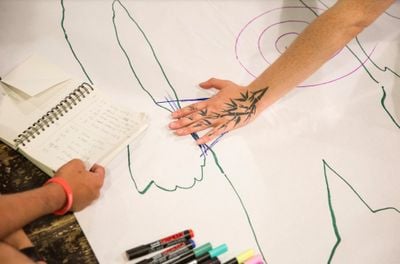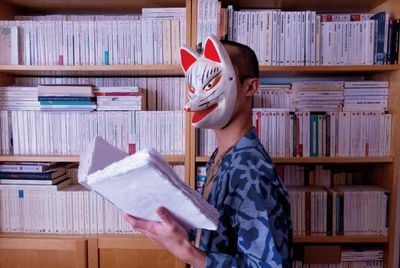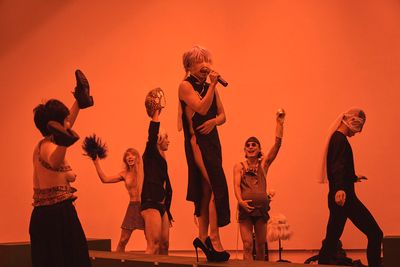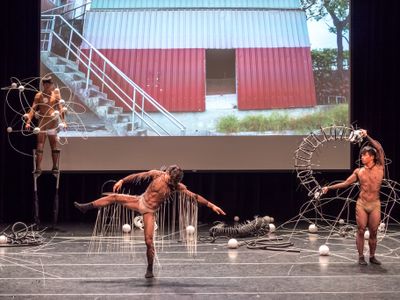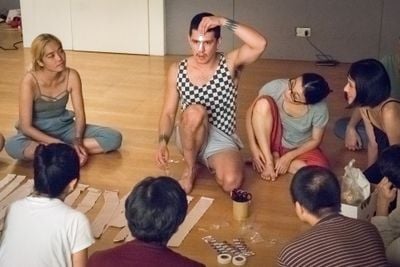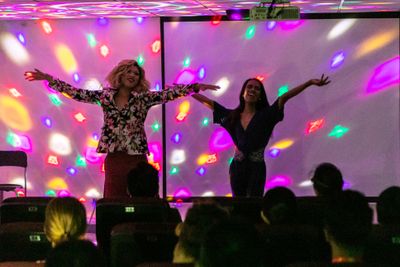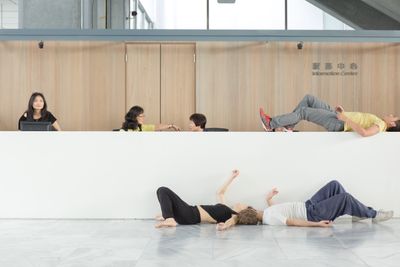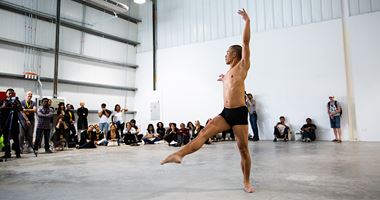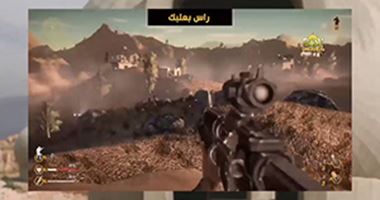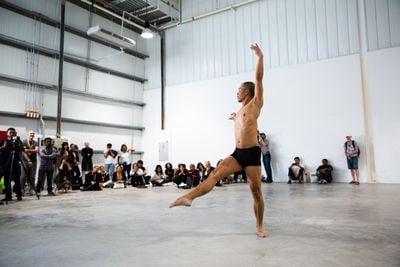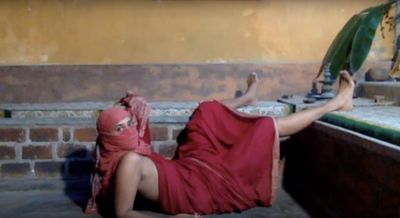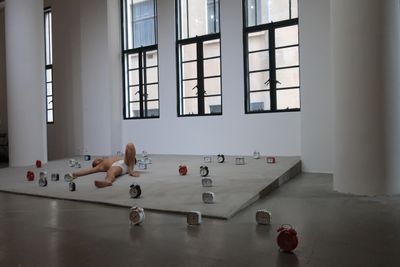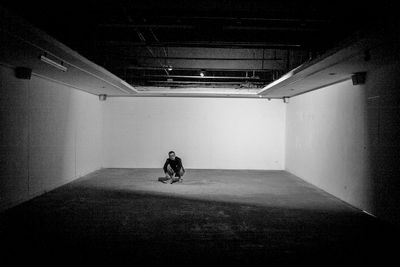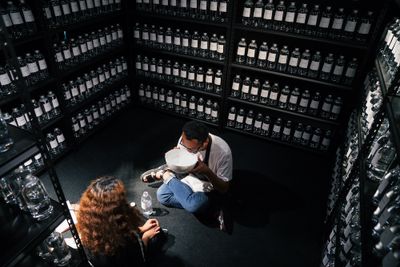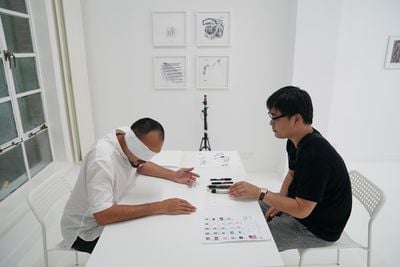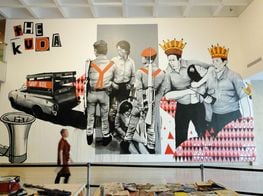River Lin: Workshopping Performance
River Lin. Courtesy the artist. Photo: Youwei Chen.
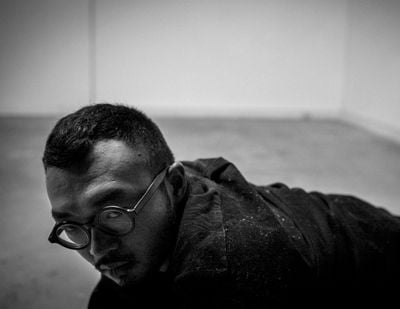
River Lin. Courtesy the artist. Photo: Youwei Chen.
A core theme running through River Lin's artistic practice is the staging of healing rituals. In Kiss it Better (2015), for example, Lin asks members of the audience to indicate where they have experienced pain, to which he responds by drinking the crimson antiseptic merbromin and kissing the area of hurt.
In these one-on-one performances, intimate moments of exchange and transference are enacted with conscious care. Bone Setting Service (2018), for example, staged as part of Tempting Failure – London's Biennial of International Performance Art and Noise (9–22 July 2018), involves participants lying down on paper so the artist can trace their outline before they mark out sites of discomfort on the drawing. At once a performance of healing and cultural translation, Lin then connects these points to the Chinese meridian system, through which 'chi' or life energy flows, and provides a massage of realignment.
Art historical references are often infused into Lin's compositions. An early performance work, River Walk (2014), engages with the embodied practice of ink painting, with Lin translating the delicate balance between water, ink, and hand by slowly moving through a demarcated frame filled with flour, through which his movements leave expressive yet considered trails, like a brush to the page.
While 20 Minutes for the 20th Century, but Asian (2016) translates Tino Sehgal's performance Twenty Minutes for the Twentieth Century (1999), a choreography that samples signature movements from the likes of Martha Graham, Pina Bausch, and Trisha Brown. Lin's version, produced in collaboration with Taiwanese dancer Wen-Chung Lin, expands the composition by adding references like Chinese folk dance, classical ballet, and yoga.
20 Minutes for the 20th Century, but Asian, Lin says, is not so much a critique as it is a challenge—a reflection of how history often omits the influences of others from dominant discourses. The performance, video, photography and installation work Huxian Memorial Hall (2019) also responds to historical omissions, this time paying tribute to LGBTQ figures and activists from across Asia in the 20th Century and today, from Wong Kar Wai's muse Leslie Cheung to Freddie Mercury, who have contributed to the struggle for equal rights.
'Taiwan, in 2019, has been comparatively fortunate becoming the first Asian country to legalise same-sex marriage', Lin explained of the project. 'However, many of the LGBTQ community in Asia still suffer'.
Lin says he came to performance late—in 2011 to be exact. In 2010, he graduated with an MA in Performing Arts from National Taiwan University of Arts, and found himself somewhat alone when it came to his interest in exploring the boundaries and possibilities of live performance art. What materialised from Lin's search for community was Asia Discovers Asia Meeting for Contemporary Performance, or ADAM: an annual residency and international gathering hosted by the Taipei Performing Arts Center.
Launched in 2017 with the aim of 'fostering the exchange, development and collaboration of contemporary art and performance in the Asia Pacific region and beyond', ADAM has welcomed practitioners from across the world, including documenta 2022 artistic directors ruangrupa, actor Bunny Cadag, artist Justin Shoulder, and dancer and choreographer Chen Wu-Kang. In 2019, Chen introduced Rama's House as part of the programme: a three-year collaboration with Thai choreographer, Pichet Klunchun, exploring the traces of the epic Ramayana in dance forms across Southeast Asia, which saw them connect with dance masters from Indonesia, Myanmar, Cambodia, and Thailand. ADAM's fourth edition, An Internet of Things, was staged online from 12 to 16 August due to travel restrictions around the Covid-19 pandemic.
In this conversation, Lin traces the development of Asia Discovers Asia Meeting for Contemporary Performance, and in turn the development of his own practice, thinking about the scales of care and translation that have developed in the process.
SBADAM was founded in 2017. Could you talk about the project's historical trajectory?
RLThe idea behind ADAM was basically rooted from my own practice. I started to make performance as an artist quite late, at around the end of 2011. At the time, I found that live performance was not really visible in the visual arts sectors or the academies in Taiwan, and there were not many visual artists doing live performance. I felt lonely, so I started to go abroad to get a better understanding of what was happening in live art practice and learn about the different contexts in which artists were performing.
In 2015, I ended up in Paris on a six-month residency funded by the Taiwanese Ministry of Culture. That was my very first experience working and living outside of Taiwan, and those experiences really opened up my mind. I started to think about how live performance practice can really straddle various disciplines, existing somewhere between art and theatre practice, because it is all about performativity.
This kind of discourse was not really visible in Taiwan, and I wanted to do something about that by bringing artists from many different disciplines together to work collectively around performance practice. I realised that this kind of network for artists in the Asia Pacific region was missing—while there are interdisciplinary artists working across Asia, there aren't many places to come together and collectively work on knowledge production around this kind of performance practice.
The reason why ADAM looks at the Asia Pacific context is because all the relevant understanding so far has been written from the Western context.
I was really motivated to do something for the ecology of performance art in the region, and I knew that I needed to collaborate with an institution, because you need funding! I proposed the idea of ADAM to the Taipei Performing Arts Center, which is a theatre complex. At the time, their building was still under construction, and I thought it could be interesting to see if they might be curious to do something different. They found it a fascinating proposition, because there is not much interaction between the theatre sector and contemporary art performance in Taiwan.
I didn't propose ADAM to an art museum because I thought that a theatre might be more open minded to take risks and try something totally new. And it happened. 2017 was a pilot stage. I was bringing people together, but still working on a format or methodology of collective working; I was learning by doing.
SBI wanted to touch on definitions, because this seems to be where performance art often has a problem. How would you define contemporary performance and how has that idea developed for you through the work that you've done with ADAM?
RLIn terms of terminology, I think people get confused in Taiwan and in many parts of Asia. In Taiwan, my experience is that when people talk about performing arts, they imagine the theatre space. By contrast, when people talk about performance art, they project the image of a solitary body, whether in public space or in a gallery space, challenging social or political circumstances. However, this is a stereotypical framing.
I think after the year 2000, something happened that cannot be easily categorised. Some artists, whether from dance, theatre, or visual arts, began creating choreographic but not dance-based works in theatre, or started to stage situations, but not in a gallery setting. This development of various settings and strategies can also be related to socially engaged art. Ruangrupa's practice, for example, is performative and process-based. What is more important in their practice is to perform the art of assembly, of getting together and learning together, and sharing time and space.
I think a new lexicon or language of performativity or performance practice in the 21st-century context has been emerging for some time. When it comes to live art practices in the contemporary art sphere, the artist's body has become a rich and flexible vehicle or container. This language of live art or performance—whether live performance, staged situations or choreographies, or social engagement—is what ADAM looks at.
I wanted to do something about that by bringing artists from many different disciplines together to work collectively around performance practice.
What's really important for me is learning from other artists and different disciplines, which is something ADAM encourages. Every year, we have artists from different disciplines coming together to talk about what they think about performance or performativity, and people really have different understandings and experiences based on their own practices. Vuth Lyno from Sasa Art Projects in Cambodia, who participated in 2019, told me that ADAM was the first time he was able to encounter such a diverse range of practices and talk about performativity.
The reason why ADAM looks at the Asia Pacific context is because all the relevant understanding so far has been written from the Western context. And although we use English to communicate with each other, through this process, we can also understand the identities and differences that are rooted in the life experiences and practices of the different participants, and in this way we can mix everything together and reimagine and expand the practice of performance.
SBWhat's so interesting is that ADAM is very much about workshopping ideas in a safe space. I participated as an observer in 2019 and the format, which is intimate and very much about development and ideas sharing, is a reminder of how important it is for practitioners to have these spaces to exchange ideas—not to exhibit per se, or even be part of a symposium, but to really be together and be vulnerable with new works and new lines of thought.
RLExactly. I like the word 'workshopping' because it really is about rehearsing and testing things together. When artists start to exchange ideas, research, and create together, something new happens. It's unexpected, really raw, and not easily defined.
This is what motivates me to work on ADAM, and to witness a discourse being built. Every participating artist has enjoyed getting lost, whether lost in translation culturally or lost in translation inter-disciplinarily. For example, learning about social engagement in Japan in comparison to Taiwan or Indonesia. Every year, as part of the Artist Lab, we also include at least one artist from Europe. So it's really about extending horizons.
SBIn this sense, ADAM is very much a space of transference and translation—in terms of how performance is interpreted, how artists interpret each other's works, but also how culture is shared.
RLThis process of translation has become my everyday practice. Being a Taiwanese or Asian living in Europe, I'm translating everything every day. When I need to access information—getting to know people, you know, drinking at parties—I am translating; people, art, politics, social cues. I have started to think about facilitation as part of artistic practice, because as an artist you are not always simply doing—you are making work or doing something by listening, translating, receiving, digesting, and then by outputting.
What's really important for me is learning from other artists and different disciplines, which is something ADAM encourages.
Doing ADAM year by year, I really enjoy this multi-linguistic situation between artists, and between artists and institutions. What I have learned from doing ADAM so far, is about translating artists' language and practice, because I am also facilitating or engaging artists to be in collaboration. I'm not a programmer or curator directly appointing artists to work together. It's more about spending time together, and eventually sensing the possibility of connection.
SBI wanted to touch on what you said about facilitating the relationship between artists and the institution, because this is something that comes through in your own work, like 8 Days, 2 Nights and 10 Artists at Taipei Fine Arts Museum (11–19 August 2017), where you curated a series of performances within the museum space, and Encounter Project: The Exhibition of Our Own, which you staged in 2016 at the Taipei Artist Village (15 January–5 February 2016), where an encounter with an artist in an empty gallery space became the work.
Could you talk about facilitation in the context of your own practice?
RLThose works are totally based on facilitating encounters, and thinking about how the artist's body could become a space for an encounter. In 2016, I staged my body in an empty gallery every day for six hours, and had one-to-one encounters with hundreds of people. Each time a visitor came to the gallery room, nothing was set up. No welcome remarks, no self-introduction. I simply saw what happened.
Sometimes my strategy was to see how a person would react. Some people would enter the room, see my body, and laugh; some got nervous and others simply cried. There were many emotional expressions from that exhibition, and I learned a lot about care through it; how to perform and show care to the audience.
But if the Encounter Project was a one-to-one act of care, then 8 Days, 2 Nights and 10 Artists was an act of collective caring. We observed and watched visitors in the museum, how they reacted to artworks, and how these observations could become a stage where we could perform and interact not only with audience members, but with institutional space—to play with the in-betweenness of something live and something static.
SBWhen you talk about playing with the in-between, I am reminded of what you said about constantly translating, which becomes an act of broadening and deepening perspectives not only of art practice but also art history through ADAM. This makes me think of 20 Minutes for the 20th Century, but Asian, a translation of Tino Sehgal's performance Twenty Minutes for the Twentieth Century (1999), which basically centres on examples of Western performance art. In your version, you include a much broader range of references you claim as part of the history of performance art, including yoga.
On your website, you group this piece with other works under the title 'Queering Body Archives'. Could you talk about that?
RLI use such terminology because the practice of queering, or queerness, not only challenges heteronormative gender politics and binary systems, but also transforms what people consider as normal or safe.
20 Minutes for the 20th century, but Asian was really challenging Tino Sehgal's original idea. If you look at Sehgal's original piece, we could say that it is very heterosexual, white, or Eurocentric, but that criticism was not my artistic motivation. My motivation was to challenge the conversation itself. Sehgal's work was a beautiful articulation of the trajectory of dance history in a Western context, but when people talk about that work, whether art critics, audiences, or institutional programmers, they never ever mentioned this Western context. So I'm responding to the fact that there is something missing in this discourse.
When I performed the work in Dubai at Asia Contemporary Art Week's annual forum in 2019, I said it was really a YouTube-based work, because in order to create it I had to look at documentation of dance performances, because my specialism is not dance at all. In that sense, it was really interesting to expand my research.
SBI love how you called 20 Minutes for the 20th century, but Asian a YouTube-based work, because that brings in ADAM 2020, which was staged online with performances devised specifically for the online frame. Could you talk about this 2020 edition? What did you learn from engaging with the internet as a performative space?
RLDue to the Taiwanese government's policy around Covid-19, we could not host any international artists this year, so like many other events we moved online. But instead of simply moving the programme online, I wanted to think about the internet's architectural conditions, which are constructed by the livestream setting—the camera and the square-based screen—and how these architectural conditions can generate alternative strategies for artists to perform their body, knowledge, or current existence.
For this programme, I was inspired by Bruce Nauman's 1968 video performance work, Wall-Floor Positions. Under the eye of camera, he moves, stages, and positions his body into the dimension constructed by the wall and the floor. At the time, visual art critics didn't consider it a dance piece—it was seen more as a performance art piece. However, I found some recent research and academic writing that considers Wall-Floor Positions as an early example of expanded choreographic work. In this way, the visual artist expands their movement in the choreographic language, as stated in this choreographic situation: within a visual art context or within video art-making.
When artists start to exchange ideas, research, and create together, something new happens. It's unexpected, really raw, and not easily defined.
Departing from Nauman's work, the title I gave one programme in ADAM 2020 was FW: Wall–Floor–Window–Positions. 'Forward' in the sense of forwarding a concept—to transport or expand it further. I also added 'window' because I wanted to invite artists to rethink the architectural conditions of the online space.
Over the first three nights, ADAM presented three episodes of FW: Wall–Floor–Window–Positions by 15 artists working in performance, dance, and visual arts practices, which we presented on our YouTube live stream channel. It was really interesting. For example, Venuri Perera staged herself in front of the camera, simply portraying herself in different poses while looking at the camera. It was beautiful and quiet, but also very powerful—an example of an artist using the situation to direct the gaze and reconstruct this relationship between the artist and the audience.
SBThere is almost a challenge to intimacy, which reminds me of Vito Acconci's video works in which he stares straight to the camera, which translates into this idea of being able to enter directly into someone's personal space through a screen.
You recently staged the online work Sleeping in between Tehching Hsieh and On Kawara, but at home for the Live Art Development Agency (13–20 July 2020), which comes out of an older work, Sleeping in between Tehching Hsieh and On Kawara, that forms part of a series around timekeeping. What was it like to transfer this piece to the online space?
RLI wouldn't say Tehching Hsieh and On Kawara have influenced my practice, but of course they are part of my ongoing research about time: making time, doing time, performing time, Western time, or working with time. For me, these two artists are very similar, yet different.
The similarity is that they both situate their art in the everyday context, but when I say everyday context, I am not talking about going shopping or cooking. The way I interpret it, it's more about the banality of the everyday; they love what is ordinary and boring, and they constantly generate and perform the borders of these contexts into artistic situations, whether through live performance or through documentation. I have also been fascinated with durational practices, too, which connects to Tehching Hsieh's and On Kawara's philosophies.
Sleeping in between Tehching Hsieh and On Kawara is normally performed by staging the body—whether mine or other performers—on a platform surrounded by 20 to 30 alarm clocks, which are timed to set off at different intervals, creating a kind of live video loop. The idea is to create a spectacle of routine. When I was invited by the Live Art Development Agency to make a video work, I wanted to create something that could become a set of instructions to a general audience about how to stage this performance themselves in the context of working from home.
SBThinking about this transference, of inviting the audience to stage the performance you once performed, how has your relationship to your performing body changed and evolved? I notice that in earlier performances, you are the one performing, but later you tend to be the choreographer or facilitator of the performance.
RLI guess the shift from performing through my individual body to other bodies happened in the Encounter Project in 2016. In that work, I was pushing my boundaries when it came to performing over long durations. At the time, I became interested in moving from individual to collective care. That's why I became interested in working with other performers to stage a situation.
When I am performing with my own body, I feel like a monk. When I practice durational performance, I always practice meditation in order to stretch my endurance. The work is very much about giving, but also receiving, or giving through receiving. To experience these conditions is very challenging, but also really good training, and I still love this ritualistic process.
When it comes to working with other people, there is a real joy to it. I feel like I become a film editor, because when you are editing a film, you cannot be a part of it; you need to be an outsider to see the image that you want to present clearly. In that sense, when I am staging a situation or working with other people, I feel like I work more like a video artist.
SBDo you see a relationship between your artistic practice and the facilitation of ADAM? It seems to relate to what you said about moving from the one-to-one exchange of care to collective care.
RLWhen I'm doing my own performance work, you could say that I'm focusing on myself much more, but when I'm leading ADAM and gathering people in Taipei, I look at those people more than myself. I feel like I have the responsibility of taking care of the situation, including the logistics. I become like a mother taking care of people, instead of taking care of my own practice.
SBSpeaking of giving and receiving, could you talk about Cleansing Service? This is part of a series of one-to-one performances based on care, in which you invite someone to come to a room and choose a bottle of water with a word on it and talk about why they chose that bottle. You then wash their hands and drink the dirty water.
RLI presented that piece, commissioned by Performance Space in Sydney in 2016, with M+ in 2018. At that time, M+ hired the gallery space of the Goethe-Institute to present work by live artists, and when I staged it, I didn't expect so many Hong Kong people to queue for this hand-washing ceremony! It was really crazy because it was too packed, and I didn't have any breaks between visitors, except for when I needed the toilet. Otherwise I was washing people's hands, drinking their dirty water, listening to their stories, and taking care of them. Imagine, I performed this for six hours per day, with each person taking ten minutes, so I encountered more than 50 people nonstop.
Cleansing Service is a caring ritual, and I really enjoyed it, because doing this kind of one-on-one performance is also a good way of doing field research. I got to know local people's anxieties and worries in Hong Kong. During the Cleansing Service, they told me their secrets because I was a stranger to them, and coming out with your secrets to a stranger is somehow easier. I really appreciated that.
SBHow does the concept of surrender work with these one-on-one pieces like Cleansing Service?
RLWhile the audience surrenders in performances like this, it is actually me that surrenders, because if I'm acting or if I'm getting tired or annoyed, people can tell. You cannot hide anything in such an intimate setting, and of course you can also sense people's emotions and their mental status. When it came to Cleansing Service, it was important that I did not carry the previous visitor's emotions into the next meeting, so I needed to train myself to digest it; to take it seriously, but not personally. I could receive someone's secret or horrible story, but I would need to come back to zero for the next visitor.
I have started to think about facilitation as part of artistic practice, because as an artist you are not always simply doing—you are making work or doing something by listening, translating, receiving, digesting, and then by outputting.
SBI love what you said about having to go back to zero because it means you return to a point of abstraction—a living monochrome. But I have to ask: how did it feel to drink the water? That was definitely a surrender!
RLMy physical feeling of drinking that water was a struggle sometimes because the water could be oily, or dusty. I remember when I performed this in Sydney and Finland, people used hand cream! It's interesting because even though I know it's disgusting, I guess I am just very confident in my stomach, my immune system, and my intestines! Every time I've performed Cleansing Service, I never really had any bad reactions. Maybe my stomach is talented!
SBOr maybe that also relates to meditation, since it can alter bodily states? On another note, Cleansing Service travelled from context to context—how did the experience change according to place?
RLFrom experience, I felt that people who live in Hong Kong have very stressful lifestyles compared to, say, people in Finland. When I performed in Kuopio in East Finland, people didn't seem to have too many issues with their life, or their concerns were different; more to do with their children's future or their environment or ecology, for example. People weren't so ready to tell me about their personal lives like in Hong Kong.
SBWhat would you say have been some of the biggest lessons that you've learned from performances like this?
RLIt may sound a bit weird, but through doing this kind of encounter with live audiences, I think I have become a better person, in terms of being kinder, more caring, less egotistical, and paying more attention to my surroundings. I really got to know that I am very small, and the world is very big, and there is so much that I need to learn.
SBSince your work is about relating across scales and contexts, how would you describe your understanding of, or relationship with, the concept of the global, given the many worlds you mediate?
RLThis is a very critical question. One way to answer this is that I enjoy being translated. But though it seems like I'm the person who is translating things, when I am translating things, I also put myself in the position of being watched and translated. I think the mediation is interactive.
In terms of the effects of the pandemic in 2020, I'm actually not very optimistic. I'm an artist who works with and for live bodies, and this makes conditions for my work more difficult than ever in this new context. I think this will challenge institutions and artists to rethink the way we can be international together, or how we can continue to exchange and come together, despite the restrictions.—[O]


